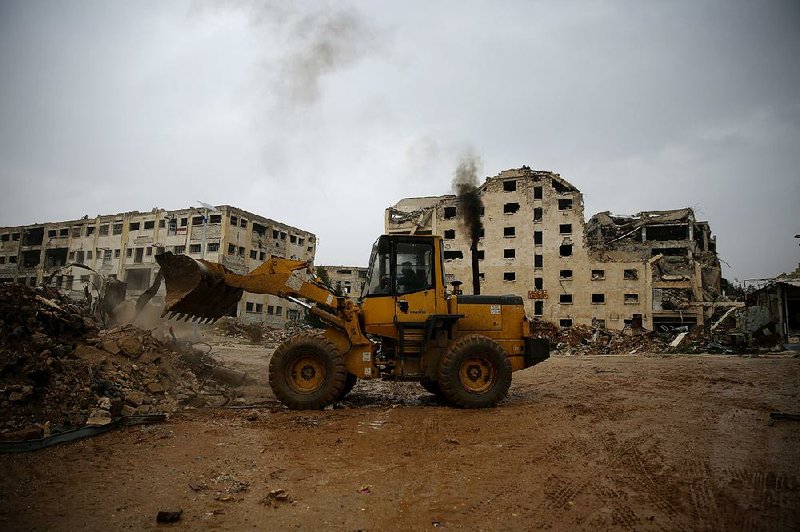HOMS, Syria -- In Homs' landmark Clock Square, where some of the first anti-government protests began in Syria in 2011, stands a giant poster of a smiling President Bashar Assad waving his right arm, with a caption that reads: "Together we will rebuild."
Four years after the military brought most of the city back under Assad's control, the government is launching its first big reconstruction effort there, planning to erect hundreds of apartment buildings in three neighborhoods in the devastated center of the city.
It is a small start to the task of rebuilding Syria, where seven years of war, airstrikes and barrel bombs have left entire cities and much other infrastructure a landscape of rubble. The government estimates that reconstruction will cost some $200 billion and last 15 years. As in neighboring Iraq, which faces a similar swath of destruction after the war against the Islamic State group, no one is offering much to help fund the process.
Moreover, destruction is still being wreaked. For the past 10 days, government forces have been relentlessly bombarding eastern Ghouta, a collection of towns on Damascus' edge, in a push to crush rebels there. Hundreds have been killed and even more buildings have been blasted to rubble in a community already left a wasteland by years of siege.
At the same time, only 6 miles away on the other side of Damascus, government workers have begun clearing rubble from Daraya, another suburb wrecked by a long siege, to begin reconstruction.
The government can cover $8 billion to $13 billion of the reconstruction costs, according to the Cabinet's economic adviser, Abdul-Qadir Azzouz. So Damascus says it will need the international community. But it also says only those who "stood by" Syria will be allowed to participate, a reference to allies Russia and Iran. That likely means lucrative rebuilding contracts will be handed to private companies from those countries, as well as probably China.
The international community, in turn, faces a dilemma. It wants to stabilize Syria to allow for millions of refugees to return -- the longer it takes, the less likely it becomes that they will go back.
But any support for reconstruction in Syria would buttress Assad and be seen as contributing to the normalization and legitimization of his government.
American officials say the U.S. will not work with Assad's government, whose leadership they describe as illegitimate.
Meanwhile, tens of thousands of square miles remain a pile of bombed-out buildings and wreckage.
Recent Associated Press drone footage from Daraya outside Damascus and from the city of Aleppo in the north shows scenes of destruction reminiscent of World War II devastation. East Aleppo, home to nearly 1.5 million before the war, is still largely empty and in ruins a year after it was recaptured from rebels.
The Homs project gives an indication of the scale of the task. The plan, to begin later this year, focuses on three of the city's most destroyed districts -- Baba Amr, Sultanieh and Jobar -- and will rebuild 465 buildings, able to house 75,000 people, at a cost of $4 billion, according to Homs' governor, Talal al-Barrazi.
It was not immediately clear how many housing units that entails -- meaning individual apartments -- but assuming an average of five people per household, that would be around 15,000 units. That's under half of the 35,000 housing units that were estimated to have been destroyed in Homs. And it's a small fraction of the 1 million housing units al-Barrazi said Syria will need.
For the past four years, any rebuilding has largely been the work of individuals, with some help from the United Nations.
In the devastated Khaldiyeh district, carpenters were fixing the windows and doors of Mohammed Bayraqdar's charred apartment. The walls inside -- even the chandeliers -- were still blackened from the fighting years ago.
The 38-year-old coffee vendor fled Khaldiyeh in 2011 and moved to his in-laws' in a government-controlled part of the city. Late last year he informed the municipality that he wanted to return home. Once government architects checked that the building is suitable for living, repair work began with the help of a U.N. rebuilding program.
"Everyone should return to his home, even if it means living in one room only," said Bayraqdar, standing on the roof overlooking a vista of flattened buildings.
Information for this article was contributed by Albert Aji of The Associated Press.
A Section on 02/27/2018
